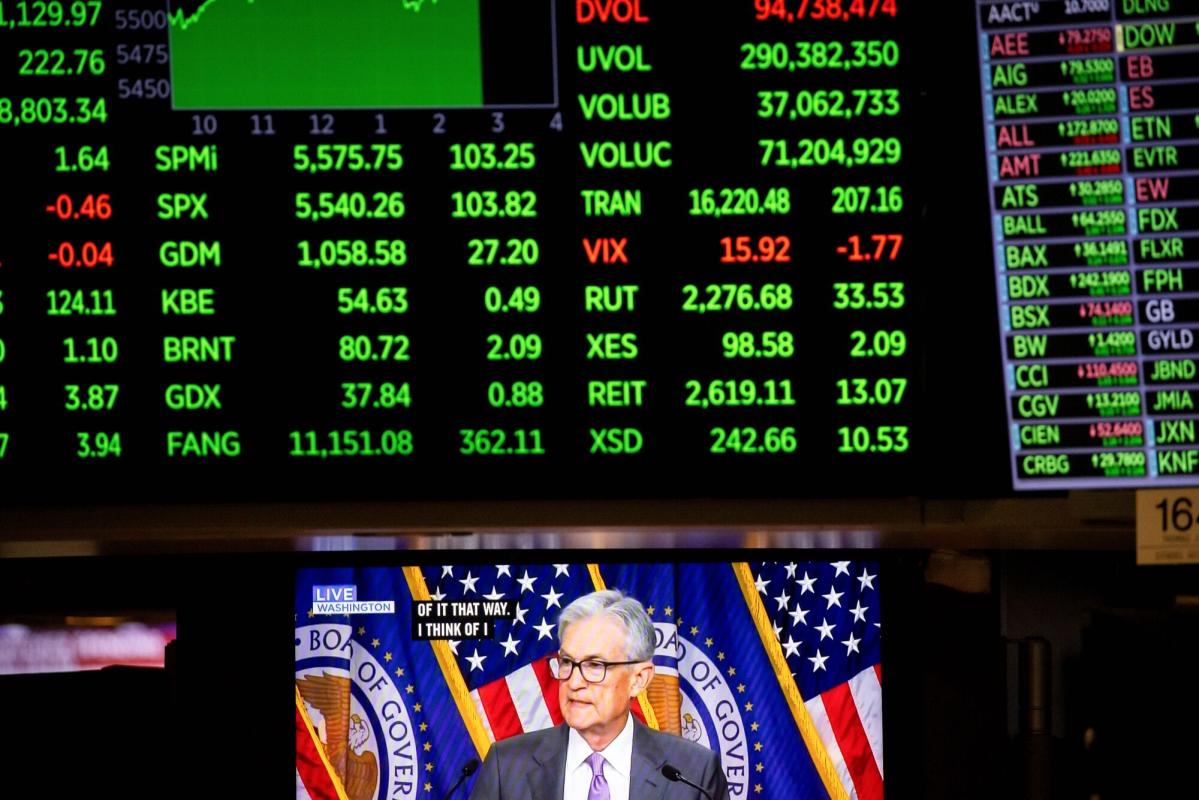Jobs
Stocks Sink Before Jobs as Tech Hit on Earnings: Markets Wrap

(Bloomberg) — Stocks fell sharply and bonds rallied as a fresh dose of weak economic data led traders to reconsider whether Jerome Powell’s Federal Reserve is wise to hold off cutting interest rates before September.
Most Read from Bloomberg
Thursday’s price action was another episode of extreme day-to-day volatility that has featured rapid rotations into and out of asset classes and sectors, with investors choosing Treasuries as the latest haven trade. The Nasdaq 100 saw its biggest one-day reversal since May 2022. In late hours, a $277 billion exchange-traded fund tracking the gauge fell as Intel Corp. and Amazon.com Inc. tumbled on disappointing forecasts and Apple Inc. whipsawed.
Swings across markets are widening as investors struggle to assess the economy and earnings at a time when the Fed’s posture is seen one day as stimulative and the next bespeaking concern about future growth. US 10-year yields broke below 4% — with swap traders now fully pricing in three rate cuts this year. In the run-up to the jobs report, data showed unemployment claims hit an almost one-year high and manufacturing shrank.
“Markets are approaching panic mode as many economic factors converge, supporting a drift away from risk assets,” said Jose Torres at Interactive Brokers. “The headwinds for this market are just too stormy, especially considering that equities are priced for perfection. What are we seeing in the economy: imperfection.”
Jerome Powell signaled this week officials are on course to cut rates in September unless inflation progress stalls — citing risks of further jobs weakening. Monthly employment data due Friday will probably add fuel to the debate. Unemployment is now close to triggering a recession indicator developed by former Fed economist Claudia Sahm that has a perfect track record over the last half-century — the “Sahm rule.”
To Neil Dutta at Renaissance Macro Research, the “ongoing deterioration” in economic data has become clear and “until the Fed begins cutting, they are going to look behind the curve.”
“Today’s selloff isn’t about earnings — it’s about whether the Fed sees what the data is saying,” said Quincy Krosby at LPL Financial. “If tomorrow’s payroll report sees the unemployment rate rising despite an increase in the participation rate, the Fed is going to have a lot of explaining to do.”
The S&P 500 dropped 1.4%. The Nasdaq 100 sank 2.4%. The Russell 2000 of small caps tumbled 3%. Wall Street’s “fear gauge” — the VIX — hit its highest since April. US 10-year yields fell six basis points to 3.97%. The pound slid as the Bank of England cut rates and signaled further cautious reductions ahead.
“Markets are having difficulty digesting today’s manufacturing data — is this a one-off, or is this the slow roll toward the recession that never happened?,” said Jamie Cox at Harris Financial Group. “Markets are thinking maybe the Federal Reserve should have cut yesterday.”
To Chris Zaccarelli at Independent Advisor Alliance, the Fed has been able to orchestrate a soft landing – so far – but that could be in jeopardy if growth slows too quickly, or inflation remains stubbornly high.
“Disappointing economic data rattled some nerves today,” said Callie Cox at Ritholtz Wealth Management. “Combine that with a Fed chair that didn’t seem to be worried about unemployment in yesterday’s comments, and suddenly investors think the soft landing may start to look more like a crash. I’m not so sure about that, though. The job market is slowing — but a slowdown isn’t necessarily a crash.”
At Capital Economics, Thomas Ryan says further decline in manufacturing raises the risk that US growth will lose momentum in the third quarter — and the plunge in the employment index will add to concern that the “Fed has left it too late to begin loosening policy.”
Powell was asked Wednesday about the “Sahm rule” after he and his colleagues decided to leave their benchmark rate unchanged at the highest levels in more than two decades. He said what policymakers “think we’re seeing is a normalizing labor market,” though if “it starts to show signs that it’s more than that, then we’re well positioned to respond.”
“There is a scenario where a rate cut would be viewed negatively for stocks and that is if the rate cut is coupled with the Federal Reserve voicing concern about the economy,” said George Ball at Sanders Morris. “While that is not a likely scenario, it is not altogether implausible.”
“The labor market has been flashing warning signals over the past several months,” said Chris Senyek at Wolfe Research. “History suggests Powell is walking a very fine line on potentially waiting too long to start cutting rates before it’s too late.”
Economists are expecting moderation in job growth in the government’s July employment report due Friday. Forecasters anticipate the unemployment rate remained steady at 4.1%.
A survey conducted by 22V Research shows 42% of investors think the market reaction to Friday’s jobs data will be “risk-off,” 36% said “negligible/mixed” and only 22% “risk-on.”
“Investors are paying the most attention to payrolls,” said Dennis DeBusschere founder of 22V. “However, the unemployment rate is a close second. Our survey consensus for the unemployment rate is 4.2%.”
The cooling economy has raised market speculation that there will be three rate cuts to come before the year is out, according to Fawad Razaqzada at City Index and Forex.com.
“In fact, there is now a greater risk tomorrow’s US non-farm payrolls report missing the mark, if today’s labor market indicators are anything to go by,” he said. “Should NFP disappoint, then the calls for the Fed to act will get louder.”
The Fed has been clear on needing more proof of soft inflation prints to cut, but labor-market slowing could lead the Fed to cut rates more aggressively, putting a November cut into play in addition to September and December, according to Oscar Munoz and Gennadiy Goldberg at TD Securities.
“Rates have moved sharply lower in recent days due to a combination of a more dovish Fed, moderating data, and geopolitical risks,” they said. “As such, a weaker reading could reinforce the move lower in rates, exacerbating the bull-steepening trend.”
Fixed-income ETFs took in a historic amount of cash last month as investors pile into the bond market, positioning for the start of a Fed rate-cutting cycle. Bond funds saw inflows of roughly $39 billion in July, the most on record, according to data from Strategas.
To Vail Hartman at BMO Capital Markets, the data won’t be as relevant to expectations for the timing of the first rate cut as it will be to the perceived likelihood the Fed ultimately needs to deviate from the “fine tuning” 25 basis-point quarterly cuts assumption as implied by its projections.
“Said differently, payrolls won’t lead the market to seriously rethink whether a September rate cut is too soon — but the information could easily skew the market-implied path of policy rates toward a more dramatic cutting campaign,” said Hartman.
The Fed is indeed a hot topic this week for global investors trying to time rate cuts. It’s also — unusually — a prominent feature on Corporate America’s post-earnings conference calls.
The words “Federal Reserve” were on track to be mentioned about 380 times on second-quarter calls with analysts, according to a Bloomberg analysis of transcripts of S&P 500 and Stoxx 600 companies. That would be the highest tally ever in the database’s records going back to 2001, if the current pace holds.
A contrarian stock indicator from Bank of America Corp. rose last month, reflecting Wall Street sentiment at elevated levels. Although the gauge remains in “neutral” territory rather than at outright “buy” or “sell” thresholds, ultra bearish attitudes toward equities are no longer a tailwind for upside like last year.
As a risk-on momentum in US stocks showed signs of easing in July, several computer-based systematic strategy funds trimmed their equity exposure. But they may not be done selling just yet.
Commodity trading advisers, or CTAs, cut their equity positions to a two-month low in July, according to Bank of America Corp. Those funds typically use a combination of price-trend signals and volatility to determine allocation. As the stock-market advance hit a snag, CTAs unwound their positions as well.
But to BofA Securities senior equity derivatives research analyst Chintan Kotecha, those CTAs that remain long US stocks should continue to cut their positions, at least in the near-term, as the rally shows signs of stalling.
Corporate Highlights:
-
DoorDash Inc. reported a stronger-than-expected profit forecast for the current quarter as the delivery company experiences resilient customer demand and growth from categories beyond restaurant orders.
-
DraftKings Inc., a leader in the online sports-betting business, reported second-quarter profit that missed Wall Street estimates and said it plans to implement surcharges for customers in high-tax states.
-
Snap Inc. shares tumbled in extended trading after the company reported disappointing second-quarter sales and gave a lower-than-expected outlook for earnings in the current period.
-
Clorox Co. rose in late trading after the maker of bleach and charcoal briquettes posted profit that outpaced market estimates, despite a decline in sales.
-
Coinbase Global Inc. posted a profit and revenue doubled as this year’s cryptocurrency recovery carried into the second quarter.
-
Booking Holdings Inc., the parent company to almost a dozen travel brands including Kayak and Priceline, reported second-quarter room nights that beat analyst expectations, a sign that demand remained strong ahead of the peak summer travel season.
-
Eli Lilly & Co. expects its blockbuster weight-loss drug to officially come out of shortage in the US in the coming days, the company’s chief executive officer said, threatening the billion-dollar industry of copycat versions of the in-demand drugs.
-
Moderna Inc.’s post-pandemic future was thrown into question Thursday after it disclosed multiple setbacks that disappointed investors..
Some of the main moves in markets:
Stocks
-
The S&P 500 fell 1.4% as of 4 p.m. New York time
-
The Nasdaq 100 fell 2.4%
-
The Dow Jones Industrial Average fell 1.2%
-
The MSCI World Index fell 1.5%
-
The Russell 2000 Index fell 3%
Currencies
-
The Bloomberg Dollar Spot Index rose 0.3%
-
The euro fell 0.3% to $1.0789
-
The British pound fell 0.9% to $1.2739
-
The Japanese yen rose 0.2% to 149.70 per dollar
Cryptocurrencies
-
Bitcoin fell 1.9% to $63,353.96
-
Ether fell 2.9% to $3,127.53
Bonds
-
The yield on 10-year Treasuries declined six basis points to 3.97%
-
Germany’s 10-year yield declined six basis points to 2.24%
-
Britain’s 10-year yield declined nine basis points to 3.88%
Commodities
-
West Texas Intermediate crude fell 1.2% to $76.94 a barrel
-
Spot gold fell 0.2% to $2,442.91 an ounce
This story was produced with the assistance of Bloomberg Automation.
–With assistance from Lu Wang.
Most Read from Bloomberg Businessweek
©2024 Bloomberg L.P.










